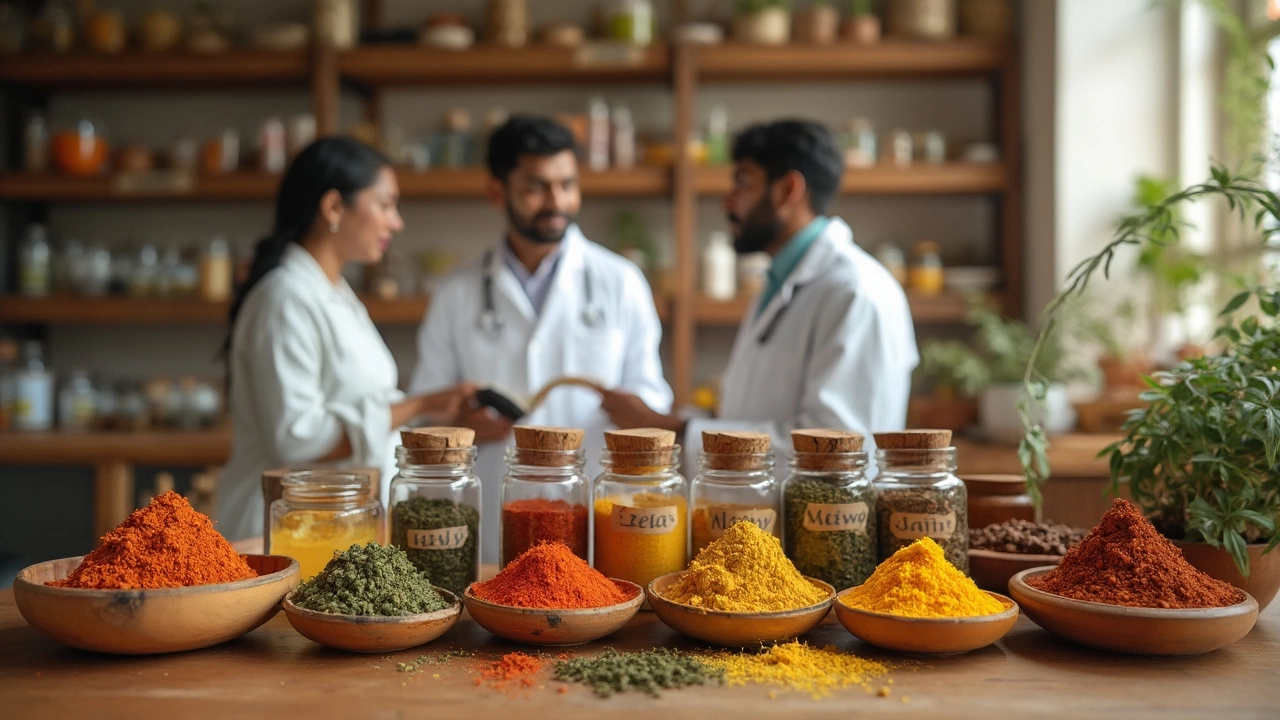
Ayurveda has been around for thousands of years, and the word itself makes people think of natural healing and herbal remedies. But just because something’s labeled “natural” doesn’t always mean it’s safe for everyone. People grab ayurvedic herbs for everything from headaches to digestion, hoping for a miracle without side effects, but that’s not how it works.
Some ayurvedic formulas do have benefits, especially when you look at milder stuff like turmeric or ginger. But when you get into complex herbal blends or traditional metal-based medicines, things can get dicey. The truth is, ayurvedic ingredients aren’t always checked for heavy metals or toxins unless you’re getting them from a legit source.
So, what should you watch out for before you jump into Ayurveda? Let’s dig into the facts, the risks, and some smart ways to keep yourself out of trouble.
- What is Ayurveda Really About?
- Are Ayurvedic Medicines Always Safe?
- Risks and How to Avoid Them
- Tips for Using Ayurveda Safely
What is Ayurveda Really About?
Ayurveda is an ancient system of medicine with roots in India that goes back more than 3,000 years. The main idea? Keeping your mind, body, and spirit in balance using diet, herbs, and simple lifestyle changes. While a lot of people think of ayurvedic medicine as just herbs, it’s actually more about a full-on approach to health that includes food, daily routines, yoga, and even massage.
The core concept in Ayurveda is the three doshas: Vata, Pitta, and Kapha. These are seen as types of energy in your body. The idea is that everyone is a unique mix of the three, and if something gets out of whack, that’s when problems start. Treatments focus on getting these doshas back in balance. So, it’s personalized, not a one-size-fits-all thing.
You’ll see a lot of familiar herbs in ayurvedic formulas—turmeric for inflammation, ashwagandha for stress, and triphala for digestion are some easy examples. But Ayurveda also gets into metal-based remedies and oil treatments, which aren’t as common in your regular health store.
What really makes ayurvedic medicine different from Western medicine is the way it treats sickness and prevention. While Western docs usually fix what’s wrong, Ayurveda is all about staying balanced so you avoid getting sick in the first place.
Check out these key facts about Ayurveda in the table below:
| Origin | Key Principle | Common Ingredients | Main Goal |
|---|---|---|---|
| India, 3000+ years ago | Balance of body energies (doshas) | Herbs, oils, minerals | Prevention & holistic healing |
At the end of the day, Ayurveda is everywhere now—from spas to supplements to your Instagram feed. The big question, though, is whether it’s always as safe as it seems. That’s the part a lot of folks skip over, but we’ll get to that soon.
Are Ayurvedic Medicines Always Safe?
Here’s where things get real. People often think all Ayurveda safety issues vanish if it’s herbal or plant-based. That’s not even close. Some ayurvedic medicines are totally safe when made right and used correctly, but there’s a flip side nobody likes to talk about.
If you buy ayurvedic medicine from a trusted store, you may be in luck. But a bunch of products, especially the ones online or overseas, aren’t tested for quality. There have been reports of Ayurveda pills containing dangerous stuff like lead, mercury, and arsenic. In fact, a study from Boston in 2008 found that about 1 out of 5 ayurvedic medicines bought on the internet contained one or more of these toxic metals at levels higher than what’s allowed in the US.
| Potential Issue | Real Risk |
|---|---|
| Heavy metals (lead, mercury, arsenic) | Can damage kidneys, nerves, or even cause poisoning |
| Herb-drug interactions | Can mess with meds for blood pressure, diabetes, or seizure control |
| Mislabeling or contamination | Undisclosed ingredients or bacteria can cause allergies or infections |
Another thing: dosage matters. Some folks think “more is better” with natural treatments, which just isn’t true. Taking huge amounts of some herbs can cause stomach problems, liver damage, or make you feel worse instead of better. Sometimes, two harmless herbs mixed together can create nasty side effects.
- Watch for ayurvedic blends that don’t say exactly what’s inside.
- If you’re pregnant, on regular meds, or have a health condition—talk to a real doctor first.
- Kids and older adults are usually at higher risk from anything untested or strong.
So, no, not all ayurvedic medicines are guaranteed safe. It comes down to the source, the quality, and making sure it fits your health needs (not just because it’s “natural”).

Risks and How to Avoid Them
Ayurvedic medicine has a reputation for being gentle and safe, but that's not always the full story. Actual studies have found that some ayurvedic medicines contain heavy metals like lead, mercury, and arsenic—not exactly the ingredients you want in your tea or pills. In the US, a study by Boston University found that about 1 in 5 ayurvedic supplements sold online had unsafe levels of these metals.
Why does this happen? Unlike regular pharmaceutical drugs, most ayurvedic medicines aren’t checked by health authorities. There’s no strict system to test for quality or purity in many places, especially if the product comes from overseas or an unknown brand. Even if you buy a product marked “herbal,” it might be mixed with other things you wouldn’t expect.
Certain herbs in ayurvedic medicine can mess with other medicines you’re taking or trigger allergies. For example, ashwagandha can boost thyroid hormone levels, so it’s risky for people with thyroid problems. Licorice root can raise blood pressure. Even the “common stuff” can have unwanted surprises.
So, how do you dodge these problems? Here’s what helps:
- Stick to trusted brands and ask for third-party test results. If a company can’t show their ayurvedic herbs are tested for heavy metals, move on.
- If you’re pregnant, breastfeeding, or have a health condition, double-check with your doctor before taking anything. Natural doesn’t always mean harmless.
- Don’t mix ayurvedic remedies with prescription meds without asking your doctor or pharmacist.
- Follow the dosage exactly—more is not better when it comes to herbals. Overdosing can cause real damage that’s hard to fix.
- Be wary of anything claiming to be a “miracle cure.” Authentic ayurvedic medicine is about balance, not quick fixes.
If you want a quick visual of some common risks, check this table with real-world data from recent studies:
| Risk | Reported Cases | Source |
|---|---|---|
| Lead, Mercury, Arsenic in products | 20% of online samples | Boston University 2008 |
| Liver injury due to herbs | Over 60 cases in Western hospitals (2011-2020) | Clinics in US, UK |
| Interactions with drugs | Mainly with heart & thyroid meds | Clinical reviews 2019 |
You don’t have to write off Ayurveda completely, but you should take the same precautions you would with anything you put into your body. Double-check everything, and don’t be afraid to ask questions until you’re satisfied with the answers.
Tips for Using Ayurveda Safely
Picking up ayurvedic medicine should feel as safe as grabbing a bottle of vitamins, but honestly, that’s not always the case. Safety depends on what you’re taking, where it’s coming from, and how you use it. Here’s how you can keep things on the safe side.
- Buy from trusted brands and certified shops. There’s a lot of fake and poorly regulated stuff out there. Go for brands with quality certifications like GMP (Good Manufacturing Practice).
- Read the label and ingredients list. Watch for mystery blends or anything with words you can’t pronounce. Some classic remedies have heavy metals like lead or mercury—no joke, a study in 2008 found about 1 in 5 ayurvedic products bought online had potentially harmful metals.
- Talk to your doctor first, especially if you have other health conditions. Mixing ayurvedic herbs with regular meds can sometimes cause bad reactions. For example, ashwagandha can mess with thyroid medicine, and guggul might interact with blood thinners.
- Start small. If you’re new to a herb or formula, don’t jump in with a full dose. See how your body responds before using it regularly.
- Skip the DIY metal-based remedies. Some traditional ayurvedic preparations (like bhasmas) involve metals. Unless prescribed and prepared by a top expert, don’t risk it.
- Keep an eye out for side effects. Rashes, nausea, stomach issues, or any new symptoms? Stop using and tell your healthcare provider right away.
Check out this quick table to see which ayurvedic herbs are generally safe, which ones to be careful with, and which to avoid unless under expert care:
| Safe (When Used Right) | Use With Caution | Usually Best to Avoid |
|---|---|---|
| Turmeric, Ginger, Triphala | Ashwagandha, Brahmi, Guggul | Bhasma (metal-rich pills), Unlabeled tonics |
Bottom line: Natural doesn’t always mean harmless. Be smart, ask questions, and don’t gamble on your health just because a remedy is “traditional.” When in doubt, look for clinical data or official recommendations. It’s your health—protect it.






